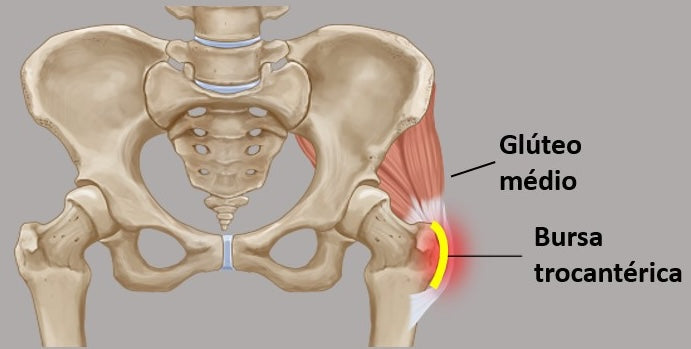
Gluteus Medius Tendonitis vs. Trochanterinitis: Differences, Symptoms, and Treatment
Share
Hip injuries are common in physically active people and can significantly affect quality of life and performance. Among the most common conditions are gluteal medius tendonitis and trochanterinitis, which share some similarities but have distinct causes and therapeutic approaches. In this article, we'll explore the differences, symptoms, and treatment options for each of these conditions.

What is Medial Gluteal Tendonitis?
Gluteus medius tendonitis refers to inflammation of the tendon of the gluteus medius muscle, which is responsible for thigh abduction and stabilizing the pelvis during gait. This condition is often caused by overuse, repetitive movements, or muscle weakness, especially in runners and those involved in impact sports.
Most common symptoms:
- Pain on the side of the hip, especially when walking or climbing stairs.
- Sensitivity to touch in the gluteal medial area.
- Muscle weakness or difficulty maintaining balance.
What is Trochantendinitis?
Trochanterinitis, on the other hand, refers to inflammation of the tendon or bursal structures surrounding the greater trochanter of the femur. This condition is often associated with trochanteric pain syndrome, which encompasses a combination of tendon inflammation and bursitis.
Most common symptoms:
- Pain located in the greater trochanter, which may radiate to the thigh.
- Discomfort when lying on the affected side.
- Feeling of stiffness or limited hip movement.
Main Differences
| Criterion | Medial Gluteus Tendonitis | Trochantendinitis |
|---|---|---|
| Location of pain | Lateral hip, close to the gluteus medius | Greater trochanter, radiating to the thigh |
| Main cause | Muscle overload or weakness | Tendon inflammation or bursitis |
| Additional symptoms | Muscle weakness | Stiffness and pain when lying on the affected side |
| Most affected population | Runners and impact athletes | Elderly people and individuals with postural changes |
Diagnosis and Treatment
Differential diagnosis between these conditions is essential and usually involves clinical and imaging tests, such as ultrasound or magnetic resonance imaging.
Treatment for Medial Gluteal Tendonitis:
- Rest and activity modification : Avoid movements that aggravate the condition.
- Strengthening exercises : Focus on the gluteus medius and hip stabilizers.
- Manual therapy and stretching : Improve flexibility and relieve muscle tension.
- Use of ice and anti-inflammatories : Reduce inflammation and pain.
Treatment for Trochantendinitis:
- Targeted physiotherapy : Exercises to improve mobility and reduce inflammation.
- Anti-inflammatory medications : Relief of pain and discomfort.
- Corticosteroid injections : In more severe cases, to reduce local inflammation.
- Biomechanical correction : Use of appropriate footwear or orthopedic insoles.
Prevention
- Avoid muscle overload : Adapt the intensity and volume of your workouts.
- Strengthen your core and hips : Improve joint stability.
- Stretch regularly : Promote flexibility of muscle and tendon structures.
- Practice good posture : Reduce the risk of misalignments that put strain on the hips.
Understanding the differences between gluteal medius tendonitis and trochanterinitis is crucial for accurate diagnosis and effective treatment. If you experience similar symptoms, consult a qualified healthcare professional for appropriate guidance.
Did you like the article? Read also:


